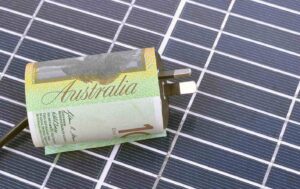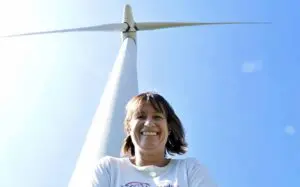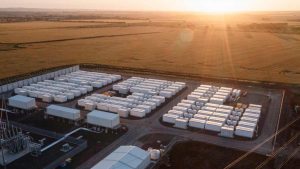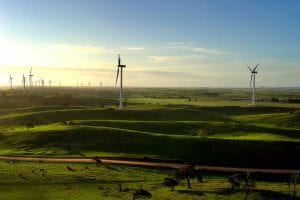The wind turbine rotating gracefully on the ridge line has long been the iconic image of carbon free, renewable power. But on the horizon (just beyond that ridge) is a problem that could put a sizeable dent in the wind industry’s clean, sleek image.
By 2050, it’s estimated that 43 million tonnes of decommissioned turbine blades will reach their end of life and need to be managed through the global waste stream.
The blades are made from low weight, high-strength thermoset polymers, capable of withstanding gale force winds and even hurricanes. Early turbines were made of fibreglass and in the last ten years they’ve been made with carbon fibre. Unfortunately, the strong bond between the epoxy and the fibre that gives them their strength is also what makes them very hard to recycle.
The current practice in the US and Europe, where the first wave of early commercial wind turbine installations are now approaching their end of life, is to bury the blades in large landfill sites. Given the projected growth of the industry this is not considered sustainable and some European countries have introduced bans on this.
Wind turbines have a life expectancy of 20-30 years. There are just over 100 wind farms in Australia, with around 15 percent of these being over 15 years old and no utility scale farms have been decommissioned yet.
Australia only has 1.18% of the 743 GW of global wind power capacity, according to a 2021 report by the Global Wind Energy Council.
Worldwide, 93 GW of new capacity was installed last year but GWEC advises this growth is not sufficient to ensure the world achieves net zero by 2050.
“The world needs to be installing an average of 180 GW of new wind energy every year to limit global warming to well below 2°C above pre-industrial levels, and will need to install up to 280 GW annually from 2030 onwards to maintain a pathway compliant with meeting net zero by 2050.”
That’s many millions of blades.
Getting to 100% recyclability
It’s widely understood that landfilling these giant blades at that scale is an unacceptable end-of life solution, and the industry needs to develop processes that are in line with circular economy principles: designing out waste, achieving 100% recyclability, and using recycled inputs.
Before making a mountain of the blade problem, it’s worth pointing out that up to 90% of the other components of a wind turbine are recyclable.
The tower and the nacelle, which contains the gearbox, rotor, bearings, hydraulics and generator, contain a large amount of steel or steel derivatives, as well as copper and aluminium. These have a well-established recycling process in Australia. (Although the paint needs removal from the tower through sandblasting which can be labour intensive.)
It’s not just the material composition that presents a problem for recycling out-of-date wind turbine blades. Early wind farms had blades 25 meters long, but newer blades can now reach over 100 metres, designed to extract maximum kinetic energy from the moving air that drives them.
The logistical hurdles and transport emissions involved in both installing and dismantling and removing a decommissioned wind farm are significant. (Watch some incredible YouTube videos of blades being transported like this one.)
The thermoset polymers require heat and must be manufactured in specialist facilities and then transported to the site. Each blade requires a specialised trailer for transport, and many are situated up winding roads in remote areas, a very long way from waste processing facilities.
Innovation in wind blade manufacturing and recycling
The race is on to find a better blade. There are a number of processes being developed by various groups with the aim of improving the sustainability of turbine blades, bringing the cost of manufacturing down, lifting performance, prolonging their life and recovering the material and energy from them at end of life.
Reaching cost parity with landfilling, however, remains a challenge.
Veolia has developed a rotor blade saw which can be used to cut up the blades into small pieces on-site, making them easier and more environmentally-friendly to transport.
Just recently, leading Danish wind farm manufacturer Vestas, along with academics and industry leaders, announced they had developed a new two-step technique for recycling old wind turbine blades.
The material is first separated into fibre and epoxy, and then chemicals are used to break the epoxy down further into base components. They say these can be used like raw materials in the manufacturing of new wind turbine blades, achieving circularity.
The dependence on chemical processing means it’s likely to be costly, but Vestas points to the potential application of the new technology in other industries such as aviation and automotives.
The search for a new recyclable plastic blade
Two groups are researching the use of blades made with thermoplastics; a French consortium and the United States’ Department of Energy’s National Renewable Energy Laboratory (NREL).
According to the US researchers, switching to thermoplastic resin would make wind turbine blades more recyclable, stronger, and enable the construction of longer and lighter blades at a lower cost.
Thermoplastics can be heated to melt and remove the resin, making it available for re-use. They also cure at room temperature, reducing costs and opening up the potential for blades to be made onsite, avoiding some of the constraints of transporting the increasingly large blades.
Thermoplastic resin-based blades are also stronger and more efficient. Researchers have shown they can absorb more energy from the wind and reduce the wear and tear from these loads to the rest of the turbine system.
Mechanical recycling and cement production
In a June 2021 the Journal of Environmental Management published the results of a study into the market potential of materials derived from wind blade recycling, mechanical grinding of fibreglass blades was shown to be a cost effective way to produce materials that can be used in cement production.
The study found that mechanical recycling was cheaper than landfilling and incineration of the blades, and there were markets available for the recovered materials.
Cement co-processing, on the other hand, involves burning fibreglass blades in a kiln and the residual glass fiber is then incorporated into cement. GE, one of the world’s largest suppliers of turbines, announced in December 2020 that it is adopting this process.
Neither of the above, however, are suitable for processing blades made from carbon fibre.
It’s clear there’s still a lot of work to be done to find a cost effective, scalable solution that will deliver true circular sustainability to the wind industry.










